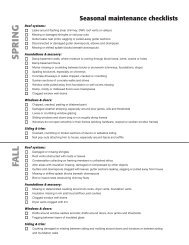Download this Stacked Stone Wall article as a pdf - Handyman Club ...
Download this Stacked Stone Wall article as a pdf - Handyman Club ...
Download this Stacked Stone Wall article as a pdf - Handyman Club ...
You also want an ePaper? Increase the reach of your titles
YUMPU automatically turns print PDFs into web optimized ePapers that Google loves.
Digging in<br />
When terracing a hill, always work<br />
from the bottom up. The crew began<br />
by digging a 12-in.-wide x 7-in.-deep<br />
trench along the edge of the sidewalk,<br />
being careful not to disturb the soil<br />
below. They smoothed the b<strong>as</strong>e, making<br />
sure it w<strong>as</strong> level with the horizon<br />
(which is typically not parallel with the<br />
grade of the sidewalk).<br />
The next step is to spread a 2-in. layincrements<br />
before starting the project.<br />
The maximum allowed height for a<br />
dry-stacked stone wall is 4 ft. Because<br />
<strong>this</strong> site’s walls are less than 24 in.<br />
high, they do not require the installation<br />
of drain tile. If they were higher<br />
than 2 ft., they would have needed a<br />
perforated drainpipe under the b<strong>as</strong>e<br />
(see illustration, opposite), and the first<br />
12 in. of stones would need to be 18 in.<br />
wide front-to-back.<br />
er of compactable three-quarter-clear<br />
gravel, which is angular and contains<br />
no crushed material. The angled surfaces<br />
of the stones help to lock them<br />
in place, preventing shifting, and the<br />
absence of crushed material allows water<br />
to drain more e<strong>as</strong>ily. (Scott says you<br />
can use three-quarter-minus gravel for<br />
<strong>this</strong> purpose but only if you have sandy,<br />
good-draining soil.)<br />
Pack the 2-in. layer using a power<br />
Cutting stone<br />
For most of the project, you can pick<br />
through the stones to find a good fit,<br />
but sometimes you need a custom<br />
shape or size. You can use these<br />
methods for cutting stone:<br />
• Chisel and hammer (score and tap<br />
along the score line with the chisel<br />
several times)<br />
• Maul (whack and hope to get lucky)<br />
• Diamond-blade g<strong>as</strong> saw (rental)<br />
• Hydraulic splitter<br />
Get the free stone mobile app at<br />
splitter<br />
Some stones have visible grain lines that http:/ / gettag.mobi<br />
To watch Scott<br />
may indicate where they are likely to demonstrate how<br />
to use a hydraulic<br />
split, but in most c<strong>as</strong>es your results will<br />
stone splitter,<br />
depend on luck. You (and any bystanders<br />
or helpers) should always wear eye<br />
scan <strong>this</strong><br />
tag or visit<br />
<strong>Handyman</strong><strong>Club</strong>.<br />
and hearing protection when cutting or com/magazine.<br />
breaking stone. — CB<br />
D<br />
For times when<br />
a stone’s fit is<br />
almost (but not<br />
quite) perfect,<br />
Scott’s crew keeps<br />
a bucket of limestone<br />
chips handy<br />
to prop the gap.<br />
These shims become<br />
tightly affixed<br />
under the<br />
weight of the wall.<br />
E<br />
<strong>Stone</strong> shim<br />
F<br />
<strong>Stone</strong> shim<br />
Each row of stones is stepped back (battered)<br />
1/4 in. along the front faces. It’s a<br />
subtle graduation, apparent only when<br />
compared with a level. Battering adds significant<br />
strength to a dry-stacked wall.<br />
Put a stone sliver (shim) in any wedge-shape openings along the back sides; then fill<br />
behind it with gravel. The shim prevents gravel from sneaking through the spaces.<br />
HANDYMANCLUB.COM 25
















